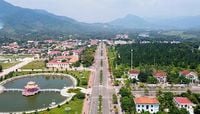On April 26, 2025, the Provincial People's Council Legal Affairs Committee convened to review a draft resolution aimed at approving the arrangement of commune-level administrative units in Nghe An province for the upcoming year. The meeting included key figures such as Nguyen Nam Dinh, a member of the Provincial Party Committee and the Vice Chairman of the Provincial People's Council, and Nguyen Nhu Khoi, another Vice Chairman of the Council.
According to a report from the Department of Internal Affairs, the province is moving forward with the establishment of a Steering Committee to oversee the reorganization of these administrative units and to develop a two-level local government model. The Steering Committee has already met to discuss and implement plans for merging several communes from various districts and towns.
The restructuring plan is significant, as Nghe An currently has 412 commune-level administrative units, which comprise 362 communes, 33 wards, and 17 towns. After the reorganization, the province will be reduced to 130 units, consisting of 119 communes and 11 wards. This represents a substantial decrease of 282 units, or 68.45%.
Among the new administrative units, 9 will remain unchanged due to meeting existing standards. Meanwhile, 29 units will be formed by merging two units, and 92 units will be created by combining three or more units. Of the 130 new units, 126 meet the required standards, while 4 have specific unique characteristics that prevent them from meeting these standards, including Nghia Dan 5, Nghia Dan 7, Chau Loc, and Nghi Loc 7.
The restructuring initiative is designed to fulfill the objectives and regulations outlined in the resolutions and conclusions from the Central Committee, the Politburo, and the National Assembly. It aims to address issues related to fragmented administrative boundaries, expand development space, and create regional links. This will facilitate the concentration of resources such as land and labor, enhance production capabilities, and ultimately improve the socio-economic conditions of the local population.
During the meeting, the Legal Affairs Committee praised the execution of the restructuring process in Nghe An, affirming that it aligns with the directives from the Central government and adheres to established principles and criteria. Local authorities have also been urged to ensure that naming conventions for the new units comply with the spirit of the conclusions regarding the administrative unit restructuring.
Participants provided feedback suggesting that the resolution's content should be presented in a more concise and comprehensible manner, and they emphasized the need for uniform terminology throughout the proposal. Some representatives expressed concerns regarding the placement of offices and the staffing of civil servants in the newly formed communes.
The committee has recommended that the drafting agency consider the suggestions made by representatives to refine the content of the draft resolution before it is presented at the upcoming special session of the Provincial People's Council.
In Hanoi, several districts and towns have also approved plans for the arrangement of commune-level administrative units. The People's Council of Thuong Tin district, during its 23rd meeting on April 25, 2025, voted to merge 27 existing communes and towns into four new ones: Thuong Tin, Thuong Phuc, Chuong Duong, and Hong Van. Public consultations revealed that over 97% of residents supported this plan.
Similarly, the People's Council of Quoc Oai district also approved the establishment of new communes, including Quoc Oai, Hung Dao, Kieu Phu, and Phu Cat, with over 95% of residents in favor. The People's Council of Son Tay town passed a resolution to create three grassroots administrative units, with public support exceeding 98.7%.
In Phu Xuyen district, the People's Council approved the formation of four new communes: Phu Xuyen, Phuong Duc, Chuyen My, and Dai Xuyen, following a similar public consultation process.
In Hue, the Director of the Department of Internal Affairs, Nguyen Van Manh, reported that the city is reorganizing its 133 existing administrative units into 40 units, which includes 21 wards and 19 communes. This restructuring will lead to a reduction of 93 units, or approximately 69.92% of the total.
The public response to this initiative has been overwhelmingly positive, with a 99.21% agreement rate from voters who participated in the opinion collection across 1,086 villages and neighborhoods.
As of April 1, 2025, Hue has a total of 23,073 officials and employees, with a payroll of 23,764, indicating 691 unused positions. The city plans to maintain the current number of civil service positions during the transition period to the new administrative units.
In A Luoi district, five newly formed communes will be designated A Luoi 1 through A Luoi 5. This naming convention, while unconventional, has received over 96% approval from local residents, as it reflects a simpler, more manageable system for administrative identification.
In a broader context, the People's Council of Thai Nguyen province has approved the merger of Bac Kan province into Thai Nguyen province. This significant administrative change will combine a total area of 8,375.21 km² and a population of 1,799,489 people under one administrative unit, with the political and administrative center located in Thai Nguyen.
Bac Kan province will reduce its 108 commune-level administrative units to 37, reflecting a decrease of 65.74%. Public consultations showed that 97.49% of voters supported this arrangement.
Furthermore, a new draft law regarding officials and civil servants is set to be discussed at the upcoming National Assembly session. This law aims to redefine the roles of commune-level officials and streamline the administrative structure by merging district-level positions into commune-level roles.
As Vietnam moves forward with these significant administrative reforms, local governments are expected to enhance efficiency, improve resource allocation, and better serve the needs of their communities, ensuring that the restructuring process aligns with national development goals and local aspirations.


